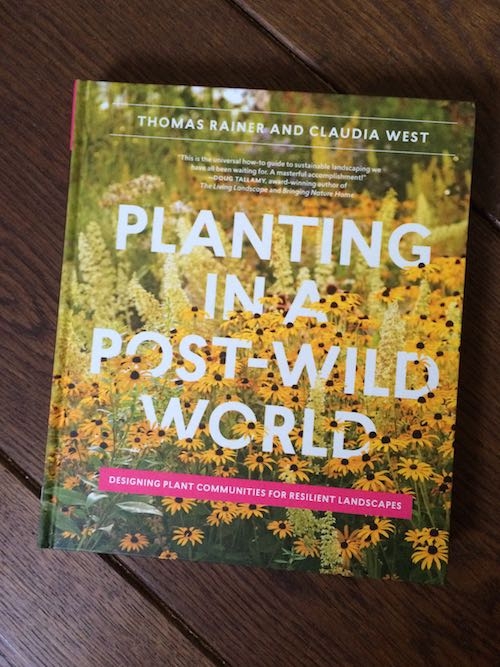Crow’s Nest: On my winter night table…
By Daniel Barringer, Preserve Manager

More like “On my coffee table” since this is a large and beautiful book…
Over the last couple months I have been working my way through this complex book on landscape design by Thomas Rainer and Claudia West: Planting in a Post-Wild World: Designing Plant Communities for Resilient Landscapes (Timber Press: 2015).
Not to drop names here, but I have met one of the authors at a book club meeting a few years ago. I met Claudia West long before I knew that she was working on a book. Probably, though, she knew she would be writing a book.
West and Rainer do not advocate a strictly native approach but focus instead on resilient landscapes that use native species and substitute non-native species when they can be functional analogs. These are low-maintenance spaces that look natural and, in our drastically human-altered world, function like natural places in providing habitat, flowers for insect pollinators, and beauty and inspiration for our senses.
Rainer is from the U.S. His story is one of habitat lost to suburban development—and what can we do in our own landscapes to make up for that. West is from the former East Germany and her story is about how resilient nature is—how it has come back in just a couple decades since industrial ravages there curtailed.
Like others who design natural landscapes, Rainer and West ask us to observe natural communities of plants and replicate some of their principles. Plants don’t naturally grow in beds surrounded by mulch—they are members of communities that share cultural requirements (conditions under which they grow well) and they weave amongst each other, filling available niches.
What sets their design principles apart is the vertical layering of plants. A typical “plan view” of a landscape design may show all areas occupied, but when you look at it at the ground view, many spaces under tall plants are empty, a place for mulch and weeds. The authors identify layers of structural and framework plants, seasonal theme plants, and ground-covering plants to fill in between. There are no sweeping masses of single species; groups of plants interact with each other and the site.
When a community is designed, as opposed to a random assemblage of plants, maintenance shifts to management. No longer are we caring for individual plants, but we are managing the conditions under which the community thrives and flows (my shorthand for the dynamic changes that also occur). The authors note that management is an affirmation that, “…design does not happen solely during the initial act of creation” (p. 61).
The photos of gardens and natural habitat are inspiring. When I have the opportunity to plan and plant I hope to employ as many of these concepts as I am able. This book joins Rick Darke’s The American Woodland Garden and Rick Darke’s and Doug Tallamy’s The Living Landscape: Designing for Beauty and Biodiversity in the Home Garden on my bookshelf for inspiration and reference.
